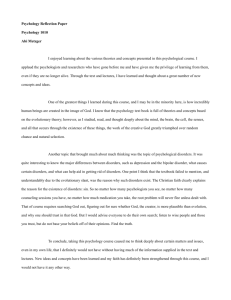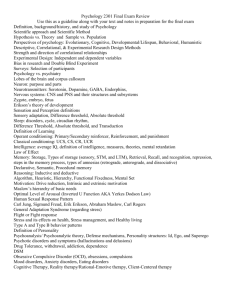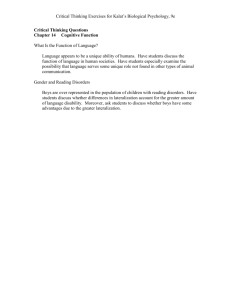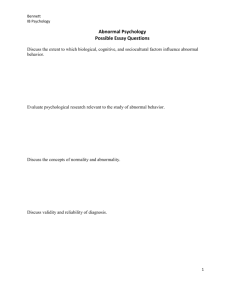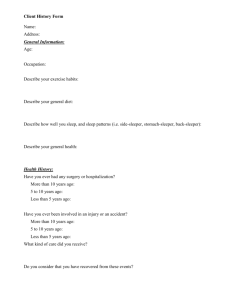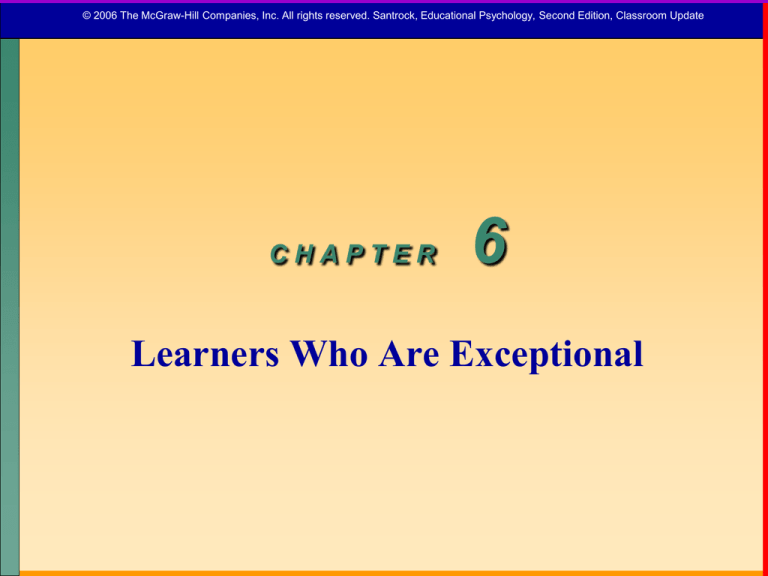
© 2006 The McGraw-Hill Companies, Inc. All rights reserved. Santrock, Educational Psychology, Second Edition, Classroom Update
CHAPTER
6
Learners Who Are Exceptional
© 2006 The McGraw-Hill Companies, Inc. All rights reserved. Santrock, Educational Psychology, Second Edition, Classroom Update
Learners Who Are Exceptional
Who Are Children
with
Learning
Disabilities?
Sensory Disorders
Emotional and
Behavior Disorders
Physical Disorders
Attention Deficit
Hyperactivity
Disorder
Mental Retardation
Speech and Language
Disorders
Learning
Disabilities
6.2
© 2006 The McGraw-Hill Companies, Inc. All rights reserved. Santrock, Educational Psychology, Second Edition, Classroom Update
Disability vs. Handicap
• A disability involves a limitation on a
person’s functioning that restricts the
individual’s abilities.
• A handicap is a condition imposed on a
person who has a disability.
6.3
© 2006 The McGraw-Hill Companies, Inc. All rights reserved. Santrock, Educational Psychology, Second Edition, Classroom Update
Laws for Special Education
1975
Public Law 94-142
1990
Individuals with Disabilities Act (IDEA)
Core Principles of IDEA
•
•
•
•
•
•
Zero Reject (Zero exclusion principle)
Free Appropriate Public Education
Least Restrictive Environment
Nondiscriminatory Evaluation
Parent and Family Rights to Confidentiality
Procedural Safeguards
•Chapter 1: Key Concepts for Understanding Special Education
Major provisions of IDEA
• Nondiscriminatory and Multidisciplinary
Assessment
• Testing students in their native or primary
language.
• Using valid tests and evaluation
• Utilizing several pieces of information.
“Copyright©
Major provisions of IDEA
Parent and Family Rights to Confidentiality &
Procedural Safeguards
• Informed Consent for testing and
placement.
• Participate on the committee.
• To inspect and review educational records.
• To request a copy.
Other Legislation
• Section 504 of the Rehabilitation Act of
1973
– Civil rights for all people with
disabilities
– Prohibits discrimination based on
disability
• Americans with Disabilities Act of 1990
– Extends to both public and private
sectors, regardless of federal funding
•Chapter 1: Key Concepts for Understanding Special Education
Who Receives Special Education?
•Autism
•Deaf-blindness
•Developmental delay (3-9) •Emotional disturbance
•Hearing impaired
•Mental retardation
•Multiple disabilities
•Orthopedic impairment
•Speech or language
impairment
•Other health
impairments
•Visual impairment
•Specific learning
disability
•Traumatic brain injury
“Copyright© Allyn & Bacon 2006”
Prevalence
•Chapter 1: Key Concepts for Understanding Special Education
© 2006 The McGraw-Hill Companies, Inc. All rights reserved. Santrock, Educational Psychology, Second Edition, Classroom Update
Sensory Disorders
VISUAL IMPAIRMENTS
HEARING IMPAIRMENTS
Low Vision
Oral Approaches
•Acuity between 20/70 and
20/200 with corrective lens
•Lip reading and speech
reading (reliance on visual
cues)
Educationally Blind
•Cannot use their vision in
learning
•Must use hearing and
touch to learn
Manual Approaches
•Sign language
•Finger spelling
6.12
Classroom Accommodations
Visual Impairments:
Determine the modality (such as touch or
hearing) through which the child learns best
Front row seating
Textbooks from “Recording for the Blind”
Use of Braille
Hearing Impairments:
Speak normally
Reduce distractions and background noises
Face the student for lip reading and gestures
6.13
© 2006 The McGraw-Hill Companies, Inc. All rights reserved.
Santrock, Educational Psychology, Second Edition, Classroom Update
Physical Disorders
Orthopedic Disorders: Restrictions of movement
because of muscle, joint, or bone problems
Cerebral Palsy
• lack of muscular coordination
• shaking
• slurred speech
Classroom
Accommodations:
• computers
• speech and voice
synthesizers
• note-taking
6.14
© 2006 The McGraw-Hill Companies, Inc. All rights reserved.Santrock ,
Educational Psychology, Second Edition, Classroom Update
Physical Disorders
Seizure Disorders: Nervous disorders characterized by
recurring sensorimotor attacks or movement convulsions
Absent Seizures
(< 30 seconds)
Brief staring spells
Twitching of eyelids
Tonic-Clonic
Loss of
consciousness,
rigidity, shakes
Classroom Accommodations
Become acquainted with monitoring procedures
Be aware of medications
6.15
Fetal Alcohol Syndrome
“This multimedia product and its contents are protected under copyright law. The following are
prohibited by law: any public performance or display, including transmission over a network:
preparation of any derivative work, including the extraction, in whole or part, of any images; any
rental, lease, or lending of the program.”
Signs and Symptoms of Fetal
Alcohol Syndrome.
• Low birth
weight
• Epilepsy
• Poor
coordination /
fine motor skills
• Hyperactivity
• Inability to
concentrate,
• Impulsiveness
“Copyright©
•Down Syndrome (Trisomy 21)
“Copyright©
•1:733 births, and
more than 350,000
people in the U.S.
“Copyright©
Down Syndrome (Trisomy 21)
• Physical Deformities
•flattening of the back of the head
•slanting of the eyelids
•short stubby limbs
•thick tongues
•heart problems
“Copyright©
FRAGILE X SYNDROME
Large testicles (evident after puberty)
Low muscle tone
short attention span
Autism and autistic-like behavior
hand biting and hand-flapping
Mental Retardation
Hyperactivity
The Normal Curve
•Bell Curve
© 2006 The McGraw-Hill Companies, Inc. All rights reserved. Santrock, Educational Psychology, Second Edition, Classroom Update
Levels of MR
•
•
•
•
Mild MR
Moderate MR
Severe MR
Profound
55-70
40-54
25-39
< 24
Autism
language and communication disorders
Poor socialization skills
Stereotypic, repetitive, self-stimulatory
behaviors
Insistence on environmental sameness
Technology
– Manual sign language
– PECS: Picture Exchange
Communication System
Learning Disabilities
– Children with Learning
Disabilities
• Normal intelligence or above
• Difficulty in one or more
academic subjects
• No other diagnosed
problem/disorder
– Identified by intelligence test and
achievement test
6.27
Academic Characteristics
• Deficits in:
•Reading
•Written
language
•Oral
language
•Mathematic
s
3 Types of ADHD
• Predominately inattentive
• Predominately
hyperactive/impulsive
• Combined
Attention Deficit Hyperactivity Disorder
Interventions
simplified instruction, modified testing,
behavior management techniques,
and clear expectations with immediate
feedback.
6.30
Behavior Modification
“Copyright©
Psychostimulants
•
•
•
•
•
Ritalin
Concerta
Focalin
Adderall
Strattera
Behavioral Characteristics
•Internalizing behaviors
Withdrawal
Easy to overlook
•Externalizing behaviors
Aggression, acting out
Readily identified
© 2006 The McGraw-Hill Companies, Inc. All rights reserved. Santrock, Educational Psychology, Second Edition, Classroom Update
Emotional Disturbance
Eating disorders – Anorexia, Bulimia
Tourette’s syndrome
Anxiety disorders – GAD, OCD,
Separation Anxiety, PTSD, phobias
– Depression, bipolar
– Schiziophrenia
Behavioral disorders
Conduct disorder
Oppositional Defiant Disorder
Speech and Language Disorders
Speech Disorders
– Articulation
• pronouncing words
incorrectly
– Voice
• hoarse, harsh, too
loud/soft, pitch
– Fluency
• Prolongation
• hesitation
• repetition
Language Disorders
– Receptive
• difficulty in
understanding
information
– Expressive
• inability to
express oneself
6.35
© 2006 The McGraw-Hill Companies, Inc. All rights reserved. Santrock, Educational Psychology, Second Edition, Classroom Update
Characteristics of Gifted Children
Divergent thinking
Have accelerated information-processing
skills
Have a passion for mastery
6.36
Classic Terman Studies
1,500 gifted individuals
Men
78 doctorates obtained
48 M.D.s obtained
85 law degrees obtained
Women 2/3 graduated from college
1/4 attended graduate school
Priorities were: 1) family
2) friendship
3) career
6.37
Classic Terman Studies
Combined (men and women) were
Not emotionally disturbed/maladjusted
Families had high expectations for them
Classroom Accommodations for the Gifted
Acceleration/enrichment in regular classroom
Special classes
Provide mentors and apprenticeships
6.38


